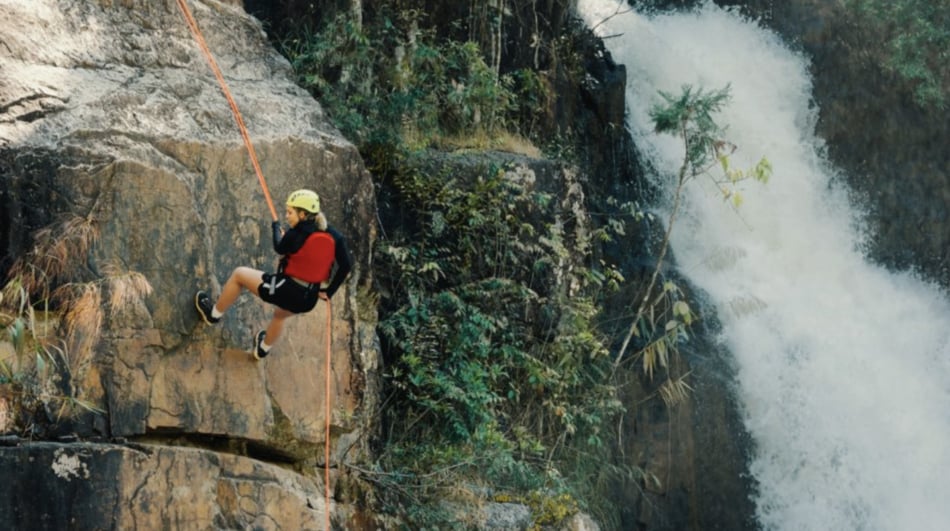
Gloves are one of the most important pieces of equipment to ensure your comfort and safety when rappelling.
So, what are rappel gloves, and why do you need them? Rappel gloves are specifically-built pieces of gear that protect your hands from rope burn while rappelling. They allow you to gain greater control of the rope, thus increasing the safety of the rappel.
Many people ignore the importance of rappel gloves, especially if they’re using their rappel as a secondary activity (e.g. to descend from a climb). The truth is, rappel gloves are an essential piece of equipment and can be the difference between a safe rappel and a potentially harmful accident. Selecting the right glove is an important step in ensuring that you have the proper gear to rappel.
What’s special about a rappel glove?
Rappel gloves are gloves that are specially designed to provide protection and comfort while rappelling. There are several differences in design that may distinguish a rappel glove from a normal one:
- Double padded areas— Many rappel gloves have extra protection in key friction areas, such as the thumb and palm of the hand, to prevent them from wearing through.
- Fingerless design— To allow for greater dexterity when tying knots and working with rope, some rappel gloves will leave the first joint uncovered.
- Grippy fabric— To help you maintain control, most gloves come with enhanced fabric on the inside of the palm to make it easier to grip your rope.
- Lightweight design— Like most climbing equipment, rappel gloves are designed to be as transportable as possible, while still retaining key safety features.
Most of the special features added to rappel gloves are there for one reason: to make it safer for you to rappel. They are built by companies like Black Diamond and Petzl, who know about the importance of climbing gear, and carry tons of extra features that will make your life easier.

Why Do You Need Rappel Gloves?
Compared to all the other equipment you need when rappelling, such as your rope and harness, it’s easy to overlook the important of gloves in ensuring your safety. Despite this, rappel gloves are a key piece of equipment that will be important in many scenarios.
Rappel gloves increase your ability to grip and control a rope, thus making it safer for you to perform your rappel. When your entire body is being supported by a strand of rope and your brake hand is the only thing preventing you from falling, you want to make sure that that hand has as much control as possible. The grippy fabric of rappel gloves will make it easier to control the speed of your descent, and will make it less likely that your hand slips.
Rappel gloves can also help prevent and mitigate injuries. The fabric will stop you from getting rope burn if you descend too quickly. The extra padding that some gloves have in key areas such as the knuckle protect your hands from bumping against sharp rocks or other objects.
In certain situations, the safety of your rappel may be compromised. You may need to descend quickly to the bottom of your rope to avoid hazards or to assist your teammates in an emergency situation. In such a scenario, rappel gloves are extremely valuable for getting you down quickly. Not only do they prevent your skin from getting flayed by the rope, they also make it easier to stop your momentum before you hit the ground.
Is There A Difference Between Rappel Gloves and Other Types of Climbing Gloves?
There are several other types of climbing gloves, such as:
- Belay Gloves: These are very similar to rappel gloves, in that they protect your hand and allow you greater control on the rope.
- Crack Climbing Gloves: These are lightweight, durable pieces of fabric that act as an alternative to taping your hands when crack climbing.
- All-around gloves: These are designed for full day, alpine adventures where you will need to perform several belays and rappels, sometimes in succession. They are often heavier-duty and may have other features, such as weather protection.
There are certainly some overlaps between rappel gloves and other types of climbing gloves. In particular, belay gloves will have mostly the same features, but with one key difference: they are designed to stay on the ground, while rappel gloves are meant to be carried with you wherever you go. This means they will often be more lightweight and will have features designed to attach to your climbing harness.
Crack gloves are designed for climbing, and are far more lightweight. They usually only provide protection for certain areas of your hand, leaving the fingers and thumb exposed. Because of that, they will not offer the same benefits as a rappel gloves.
All around climbing gloves will certainly function for a rappel, although similar to belay gloves, they may have more features than necessary if all you require them for is rappelling.
When Should You Carry Rappel Gloves?
As I said above, rappel gloves often get overlooked as a key piece of safety equipment. Deciding what gear to bring with you when climbing or rappelling is always an exercise in balancing weight with the necessity of the gear. Whether or not you should carry gloves depends on what kind of trip you’re going on and the likelihood that you will need to use them.

If you’re heading out somewhere to rappel specifically, you should definitely carry a pair of gloves. They’re light-weight, packable, and offer great safety benefits. Similarly, if you know you’re embarking on a long climbing expedition, such as a multi-pitch climbing route, it can never hurt to strap a pair of gloves (rappel, belay, or all-around) to your harness. Over the course of a long day of climbing, your hands are bound to get sore, and gloves will ensure that both you and your partner get down safely.
If you’re headed out for a day of cragging and you know that the most rappelling you’ll be doing will be short, controlled descents from the top of a sport route, rappel gloves may not be as essential. Personally, I don’t use belay or rappel gloves in I know the most I’ll be doing is a 15-meter descent, especially if I’m on belay; if I get to the top and decide my hands are too sore to safely rappel, I can always just get my partner to lower me.
Sometimes on scrambling or mountaineering trips, I carry a length of rope and an ATC just in case I ever need to perform an emergency rappel. If you believe that there’s a chance you’ll have to use them, rappel gloves are a great way to augment your backup ‘get down safe’ kit, and they’re lightweight enough that it often makes sense to pack them.
What Rappel Gloves Do You Recommend?
As with any purchase, finding the right pair of rappel gloves is going to be a matter of personal preference. Before buying a pair of gloves, there are several questions you should ask yourself, such as:
- What do I want the gloves for? Are you looking for strict rappel gloves, all-around climbing gloves, or something in between?
- How often am I going to us them? Durability is important, but so is price. If this is your first rappelling expedition, it might be better to just pick up a cheap pair of gloves so that you can get a taste of it before really committing. If, however, you know you’re going to be rappelling often, it makes sense to spend a little money and get something more long-lasting.
- What are my personal preferences? Do you like synthetic fabric or leather? Do you like the dexterity of fingerless gloves, or do you want something a little more protective? Is thick padding important, or are you hoping to have a little bit more feel of the rope? These are all questions you should answer before committing to a pair of gloves.
Personally, my favourite pair of rappelling gloves are the Black Diamond Crag Gloves. I’m a big fan of buying versatile gear, and these gloves fit the bill; they work for rappelling, belaying, and even offer a little insulation for cold mornings when scrambling. They versatile and durable, and I would highly recommend picking up a pair by following the link above.
Conclusion
So, there you have it. In the article above, I not only discuss what rappel gloves are, but why they’re important and how you can go about purchasing your own set.
Remember: rappelling is a dangerous activity, with potentially life-threatening consequences. Please take all necessary precautions to ensure your safety before you head out on a rappel.
Related Questions
How Much Do Rappel Gloves Cost?
Like everything else, price varies with quality. It’ll depend on a few factors, like what brand you buy and what material they’re made out of, but most gloves will be in the $30-$50 range.
Will a non-rappel glove work for rappelling?
Many gloves can perform decently well for rappelling, in that they will protect your hand from rope burn. However, you will wear out your gloves more quickly if you use them for rappelling, and you might not have the same amount of control on your rope as you would if you used a rappelling-specific glove.
